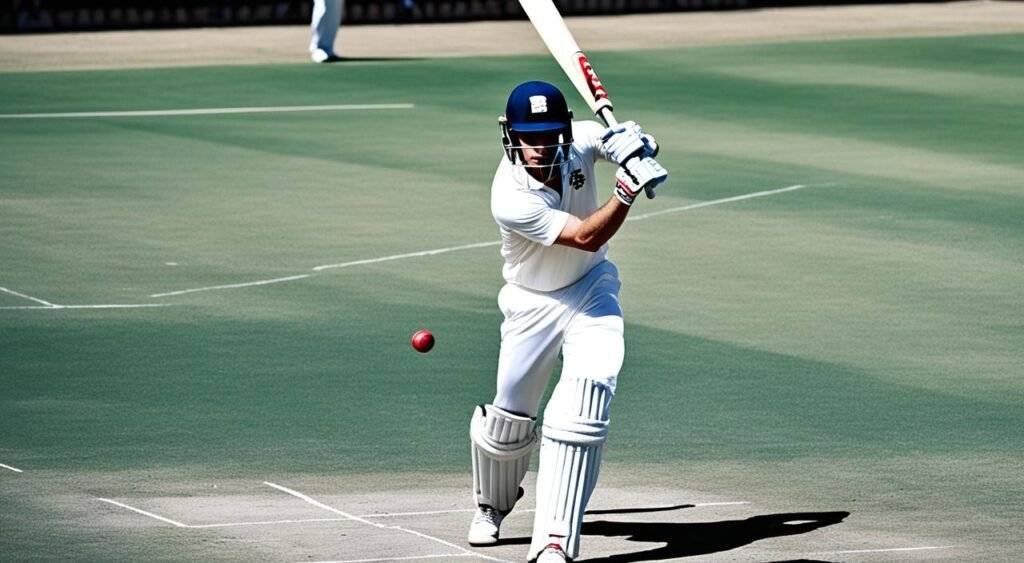As the sun rises in Australia, the stadium buzzes with excitement. It’s a Test match, and everyone feels the tension. Steve Smith, however, sees opening challenges as routine. He’s known for his focus and batting skills. Smith has built a strong mental game over the years.
He turns challenges into chances, whether facing Dale Steyn or R. Ashwin’s spin. Being an opener is tough, but Smith is ready. He’s all set to take on the opening challenge in Tests.

Key Takeaways
- Steve Smith’s approach to the opening challenge showcases his resilience and determination.
- The significant pressure opening batsmen face in Test cricket can be daunting.
- Smith’s historical performance highlights his ability to thrive against top opposition bowlers.
- Mental toughness is crucial for batsmen, especially when starting an innings.
- Understanding pitch conditions is vital for formulating a winning batting strategy.
Introduction to the Opening Challenge in Tests
The opening challenge in tests is a key part of cricket. Here, the first batsmen face tough early deliveries and high pressure. They set the tone for the innings. They must handle the best bowlers and early pitch movements.
Opening batsmen face many challenges. They must adjust to different pitches and bowling styles. They also deal with crowd and critic pressure. This makes staying mentally strong and focused crucial.
Starting well sets the innings on the right path. Teams that fail at the top struggle to catch up later. The opening role requires skill and mental strength. Understanding the opening challenge shows how complex top-level cricket is.
The Significance of the Opening Position in Cricket
The opening batsman is key in cricket. They set the innings’ tone and face top bowlers from the start. It’s important to understand the skills needed and how it affects the team.
Understanding the Role of the Opening Batsman
Opening batsmen need both technical skill and mental toughness. Facing fast bowlers and tricky conditions can be tough. Yet, they manage these challenges well, making the innings stable. They help build strong partnerships, setting the stage for big scores.
Impact on Team Performance
A great opening partnership boosts team performance. When openers do well, it opens up more scoring chances for others. This teamwork at the top can start a winning momentum, affecting both batting and fielding. So, the opening batsmen play a key role in the game’s outcome.
| Criteria | Impact of Opening Batsman |
|---|---|
| Partnership Building | Establishes a strong foundation for the innings. |
| Facing Conditions | Shows adaptability to different pitch and weather conditions. |
| Mental Agility | Handles pressure from quality bowlers effectively. |
| Team Dynamics | Boosts confidence and sets an aggressive tone for the team. |
Smith’s Resilience Against Opposition Bowlers
Steve Smith has shown amazing resilience against top bowlers in cricket. He excels under pressure, thanks to his skill in reading the game and adjusting his batting. His success against different bowlers proves his skill and strong mental game.
Analyzing the Key Opposition Bowlers
Smith has faced many elite bowlers in his career. Some of the key ones include:
- James Anderson
- Stuart Broad
- Jasprit Bumrah
- Kagiso Rabada
- Mitchell Starc
Dealing with these bowlers means knowing their styles and plans. Smith’s ability to change his batting helps him score runs against tough opponents.
Matches Where Smith Thrived
Some matches show how well Smith performs in tough situations:
| Match | Opponent | Runs Scored | Bowler | Performance Highlight |
|---|---|---|---|---|
| 1st Test, Ashes 2019 | England | 144 | James Anderson | Stood firm during a crucial partnership |
| 3rd Test, 2020 | India | 131 | Jasprit Bumrah | Survived intense bowling spells, showcasing technique |
| 2nd Test, 2018 | South Africa | 88 | Kagiso Rabada | Displayed grit in a low-scoring match |
These examples show Smith’s skill in turning tough situations into big scores. This makes him one of the top batsmen in cricket today.
Smith’s Opening Challenge in Tests
The challenge for Smith as an opening batsman in tests is tough. He must face strong bowlers on challenging pitches. His skill and strategy are key to success in these tough moments.
Smith knows how to read the game and find bowlers’ weak spots. He studies the bowlers to spot the best times to score. This helps him defend well against seam and swing.
Through hard work and experience, Smith turns his analysis into great test match performances. He creates strong partnerships that help his team.
To show his journey, here’s a table that outlines Smith’s test match performance in relation to specific challenges he has encountered:
| Test Match | Bowler Faced | Runs Scored | Pitch Condition | Challenges |
|---|---|---|---|---|
| 1st Test vs India | Jasprit Bumrah | 92 | Seaming Early | Handling Bounce |
| 2nd Test vs England | James Anderson | 76 | Dry and Cracked | Fading Ball Challenges |
| 3rd Test vs South Africa | Dale Steyn | 101 | Dusty Turners | Playing Spin Early |
In these examples, Smith shows his strength by adjusting his batting to each test match’s challenges. His hard work in overcoming the smith opening challenge in tests has made him a top opening batsman today.

Assessing Pitch Conditions and Their Impact
Knowing how pitch conditions affect batting is key for opening batsmen. Different pitches bring their own challenges. For Smith, adjusting to these conditions can change the game’s outcome.
How Pitch Conditions Affect Batting Strategy
Pitch conditions shape batting strategy, affecting shot choice, footwork, and confidence. Key points include:
- Turn: Pitches with spin need changes in technique, especially against spinners.
- Bounce: High-bouncing pitches call for aggressive shots, while low-bouncing ones demand caution.
- Pace: Fast surfaces mean quick play and fast reflexes, affecting a batsman’s score.
Adaptation to Varying Conditions
Smith shows his skill in changing his technique for different pitches. This flexibility makes him a strong opener. Key parts of his adjustment include:
- Looking at the pitch during warm-ups and early overs.
- Adjusting his stance and footwork based on the pitch’s seam or spin.
- Choosing shots that match the pitch’s pace or bounce.
Smith’s skill in handling tough pitches shows how dynamic Test cricket is. Understanding and adapting to these factors can improve performance and create more scoring chances. This adaptability is what sets top players apart in today’s competitive cricket.
| Pitch Type | Impact on Batting | Recommended Strategies |
|---|---|---|
| Dry and Cracked | Increased spin, lower bounce | Use of forward defense, placement shots |
| Green Top | Extra seam movement | Careful shot selection, focus on playing late |
| Batting Paradise | Even bounce, minimal seam or spin | Aggressive approach, running between wickets |
Batting Strategy: Smith’s Approach
Steve Smith’s batting strategy is a mix of skill and quick thinking. He changes his game to meet the challenges of Test matches. He takes smart risks and knows how to score during play. This lets him do well against different bowlers.
Scoring Options for Smith
Smith has a special way of scoring. He keeps the game moving by rotating the strike. Here are some of his key scoring moves:
- Utilizing footwork to create angles against bowlers.
- Targeting gaps in the field for quick singles.
- Employing unconventional shots, which can unsettle bowlers.
- Building partnerships with fellow batsmen to increase overall scores.
Utilizing Mental Toughness
Mental strength is key to Smith’s success. In the tough world of Test cricket, staying calm under pressure sets him apart. Here’s how he stays mentally strong:
- Remaining focused despite external distractions.
- Recovering quickly from mistakes and setbacks.
- Maintaining confidence in his game plan during tough phases.
- Staying calm while executing high-stakes runs.

Performance Pressure in Test Matches
Opening batsmen in Test matches face huge pressure. They must handle the new ball and meet the hopes of fans, selectors, and teammates. How they manage this pressure is key to their and their team’s success.
Handling Expectations as an Opening Batsman
Opening batsmen deal with special challenges, like the pressure they feel. High expectations can be scary, as they need to perform well under the watchful eyes of fans and critics. To cope, they use mental preparation, set personal goals, and have a strong support system.
- Mental Preparation: Building mental resilience to tackle high-pressure situations.
- Personal Goals: Setting realistic, achievable goals to foster self-confidence.
- Support System: Leaning on teammates and coaches for encouragement and advice.
Smith’s Previous Test Match Performances
Steve Smith has shown he can handle pressure well, often performing well in big games. His notable innings have made him known as a reliable opener who can handle the pressure.
| Match | Opponent | Score | Performance Pressure Level |
|---|---|---|---|
| 1st Test, 2017 | India | 140 | High |
| 2nd Test, 2018 | Pakistan | 162 | Moderate |
| 3rd Test, 2019 | England | 92 | Very High |
Smith’s success in these situations shows his skill and mental strength. It proves he can handle the pressure well.
Challenges Faced by Opening Batsmen
Opening batsmen in Test matches face special challenges. They don’t have the chance to score quickly like in limited-overs cricket. Instead, they need a strategic mind and great resilience. They must handle top-notch bowling attacks from the start, needing deep game knowledge and top skills.
Cricket Challenges Unique to Test Matches
Long matches in Test cricket make fatigue a big issue. Players must stay focused and strong for up to five days. Starting an innings brings big emotions and high hopes. Opening batsmen must balance being bold and careful, making key shot choices under tough conditions.
Players like Steve Smith face huge pressure to perform well in these long matches. Even small changes in the pitch can affect their game. This shows how much skill and mental strength opening batsmen need.
FAQ
What is the significance of the opening position in Test cricket?
The opening position in Test cricket is very important. It sets the tone for the innings. A strong opening partnership can lead to more runs and momentum for the team. This can affect the team’s performance throughout the match.
How does Steve Smith prepare for the challenges of opening in Test matches?
Steve Smith gets ready by studying the pitch and the opposition’s bowlers. He plans his batting based on the match situation. He shows resilience under pressure by adapting his strategy.
What are the key challenges faced by opening batsmen in Tests?
Opening batsmen face tough challenges like facing top-quality bowlers and varied pitches. They also feel the pressure of starting an innings. They need good tactics and mental strength to do well in this role.
How does pitch condition affect a batsman’s performance?
The pitch can greatly change how a batsman plays. Things like turn, bounce, and moisture affect his strategy. Knowing how to adjust to these conditions is crucial for success in Test matches.
What mental aspects contribute to Steve Smith’s success as an opening batsman?
Mental toughness is key for Steve Smith’s success. He can handle the pressure, manage expectations, and stay focused. These skills help him perform well in Test cricket.
Can you highlight some specific matches where Steve Smith excelled against top bowlers?
Steve Smith has done well against some of cricket’s best bowlers. His technique and strategy helped him score important runs. These matches show his ability to perform well under pressure against tough opponents.
What distinguishes Smith’s batting strategy compared to other batsmen?
Smith’s strategy is unique because of his scoring options and how he plays against tough bowling. His smart risks and consistent resilience make him stand out in Test cricket.
How does performance pressure impact Steve Smith?
Steve Smith faces a lot of pressure as an opening batsman. But his experience and mental strength help him handle it well. This often leads to great performances, even when the stakes are high.




